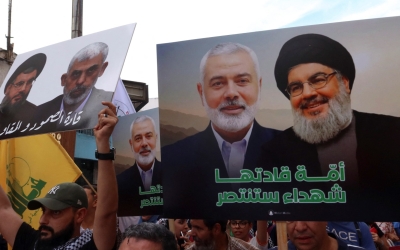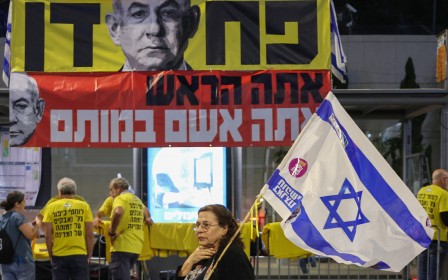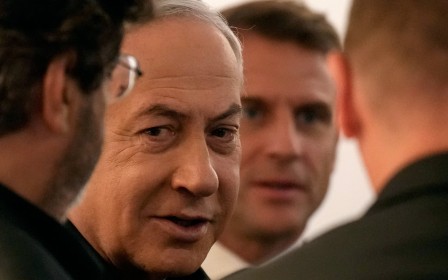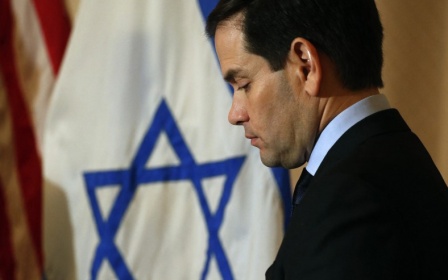After Lebanon ceasefire, Netanyahu is running out of cards to play

When Hezbollah’s late secretary general, Hasan Nasrallah, was killed by 10 bunker-busting bombs dropped on a bunker 60 feet below ground, there was jubilation on the streets of Israel.
"Oh Nasrallah, we’ll take you down, God willing, and send you back to God along with all of Hezbollah," were the lyrics of a song blasted from one apartment building in Tel Aviv.
A lifeguard announced to swimmers: "With happiness, joy and cheer, we announce officially that the rat Hassan Nasrallah was assassinated yesterday. The people of Israel live." And in common with received wisdom at the time, The Spectator proclaimed: "Nasrallah is dead and Hezbollah is broken."
Only two months later, the mood in Israel is very different. Just 11 days ago, the defence minister, Israel Katz, said that the goal was to disarm Hezbollah and create a buffer zone in south Lebanon.
The army secured neither and the Israelis knew it.
New MEE newsletter: Jerusalem Dispatch
Sign up to get the latest insights and analysis on Israel-Palestine, alongside Turkey Unpacked and other MEE newsletters
Asked in a poll who won after nearly 14 months of fighting, 20 percent of the Israelis polled said they believe Israel to have won while 19 percent said Hezbollah did. Fifty percent of people said that the fighting was set to end without a clear victor, while 11 percent said they didn’t know.
The operation that killed Nasrallah was named: "New Order". And to establish a narrative of victory, the myth persists today that Hezbollah has been "battered and diminished" by 13 months of war. Weakened and isolated, it was desperate for a ceasefire, the New York Times confidently opined.
Lethal leaks
Hezbollah’s first and second ranks of leaders have indeed been decimated. The booby trapped pagers and walkie talkies were devastating, but only to the people issued with them, who were administrative and political functionaries. Pagers were not used by fighters.
The biggest knock to the confidence of the organisation was the intelligence leak that killed Nasrallah’s presumed successor, Hashem Safieddine, in a powerful Israeli strike on a secret subterranean Hezbollah base on 3 October.
Safieddine is believed to have been killed within minutes of arriving at a meeting of Hezbollah’s shura council. The strike was so powerful it demolished four large residential buildings.
And theories as to how Israeli military intelligence could have achieved this penetration continue to bounce back and forth between Lebanon and Iran, Hezbollah and the Islamic Revolutionary Guard Corps (IRGC).
Is there a mole, at the level of a general, in the IRGC?
Exactly who knew on which floor of an IRGC guesthouse Ismail Haniyeh, the political leader of Hamas, and his bodyguard were sleeping, and when they would go to bed? Haniyeh had guests until he went to bed at 3am.
We know the CIA has trained thousands of the Iranian opposition group Mojahedin-e Khalq (MEK) fighters in Albania, but even so how did Israel get this very specific time-sensitive intelligence?
Has the US got the technical capability to bug what were once considered highly secure communications between Beirut and south Lebanon remotely?
No one yet knows.
A similar investigation is being conducted in Syria. And this counter-intelligence manhunt has undoubtedly created a hiatus in command and control.
But there is one fact that cannot be explained away easily by Israeli and US military briefers. How did Hezbollah keep control of the battlefield without having a functional command operating out of its headquarters in Dahiyeh, Beirut?
It is indisputable that this allegedly "weakened and debilitated" Hezbollah has put up a much stronger fight than either 1982, when Israelis soldiers took only five days to reach Beirut, or 2006.
Most potent weapon
Instead of creating a buffer zone, the invading Israeli force spent two months bogged down on the border, unable to penetrate or hold positions more than four kilometres inside Lebanon and having to stage frequent retreats. This, despite staging a blitzkrieg in the towns and cities across Lebanon.
Hezbollah's most potent weapon is one that their enemy can never possess, despite an overwhelming technological advantage. It is their social base
Israeli elite units, like the Golani Brigade, have taken a hammering, losing at least 110 deaths in combat since 7 October, 2023. From the day they crossed the border, they were ensnared in premeditated traps.
In one engagement, a Golani scouting unit walked into a Hezbollah "fortress" resulting in the death of one soldier, serious injuries to a company commander and light injuries to the brigade’s chief of staff. Reservists had to be withdrawn from the fight totally.
Anyone who knows how Hezbollah trains could have told you why this should come as no surprise. Each unit is prepared and stocked to fight on its own for two years. They communicate and coordinate with each other over fibre optic cable.
The preparation is as much mental as physical, with battlefield commanders selected after six years of training in philosophy, according to one source granted rare access to them.
They think long term. They fight a war of attrition which is planned to run for decades, not weeks or months. But their most potent weapon is one that their enemy can never possess, despite an overwhelming technological advantage. It's their social base. They are from and of the villages and towns they defend.
That's why neither Israel nor the Lebanese army could stop the convoy of villagers returning jubilantly and defiantly to their ruined homes within minutes of the ceasefire taking effect.
The moment Israel stopped fighting, they lost control.
The other arm of the "bruised and battered" narrative is the contention that Hezbollah is now more isolated politically than before because of the damage that the whole of Lebanon has sustained.
If anything, the opposite is the case.
Such is the hatred and humiliation Israel has stirred in Lebanon, and indeed every country in the region, by its bombing campaign in the last two months and its campaign of extermination in Gaza, that some of the bitter divisions created by the civil war in Syria are starting to heal, though as events this week have shown in Syria, those scars have not gone away.
But the last 13 months of war on Gaza showed that a "Sunni" Palestinian resistance movement can join forces with a "Shia" Lebanese movement in a fight against a common enemy.
This alone has done much to refocus Sunni and Shia energies throughout the region. The policy of pacifying the region by practising divide and rule no longer works for Israel the way it once did.
For there is a major psychological change going on in the Sunni Arab world that has erased the logic of the Abraham Accords. Peace can no longer be achieved by recognising Israel, still less installing it as the regional technological, military and economic hegemon.
This change has made even the current Saudi leadership, the least sympathetic to the Palestinian cause, and the most transactional in the history of the kingdom, recoil.
After several decades in the freezer, Arab nationalism and armed resistance to occupation has been fused under the banner of Islam.
Potent forces are being released by this fusion and they no longer work against the Axis of Resistance, that network of sub-state armed groups throughout Iraq, Syria, Lebanon and Yemen that Iran constructed as a form of deep defence after the trauma of being invaded by Saddam Hussein’s Iraq.
Iran’s influence throughout the Arab world has perennially been constrained by the confessional and sectarian realities of power in Iraq, Syria, Lebanon and Yemen.
And until today, it had difficulty breaking out of that barrier.
Misreading the Middle East
The Israeli Prime Minister Benjamin Netanyahu, in particular, and the power-drunk behaviour of Israeli forces in Gaza, Occupied West Bank and Lebanon in general, has helped Iran break out of those constraints.
For many in the Arab world, Iran is seen less as an unwanted intruder in the Arab space, and more as the regional spearhead of resistance against colonial control. If it continues, this is a major change a decade after the schisms created by the Arab Spring.
Even after the battering Gaza has received in the last 13 months, Hamas is in no mood to wave the white flag
In short, Hezbollah has proved once again to be a staunch enemy for Israel that cannot be eliminated. If previous experience is anything to go by, it will emerge even stronger.
But nothing impedes Israel and America’s ability to misread the Middle East.
Hezbollah’s "capitulation" in accepting a ceasefire, while Israel continues to pound piles of dust in Gaza, is seen as the precursor to a similar capitulation by Hamas.
Hamas, too, is being written off as "on its knees" after the death of its leader Yahia Sinwar, although it continues to operate even in the hell hole of north Gaza where all food supplies have been cut off for 50 days.
But this, again, is wish fulfillment disguised as analysis.
Even after the battering Gaza has received in the last 14 months, Hamas is in no mood to wave the white flag.
In one of several statements made since the ceasefire was announced, Hamas took heart from Netanyahu having to accept a deal which fell far short of his military aims in Lebanon.
Hamas said in a statement that "accepting the enemy's agreement with Lebanon without fulfilling his conditions, is an important station in destroying Netanyahu's illusions of changing the map of the Middle East by force, and his illusions of defeating the resistance forces or disarming them."
The movement expressed its commitment to "cooperate with any ceasefire efforts in Gaza, within the determinants of stopping the aggression on Gaza, which we agreed to nationally; namely the ceasefire, the withdrawal of the occupation forces, the return of the displaced, and the completion of a real and complete prisoner exchange deal."
This position has changed little since Hamas accepted a ceasefire proposal from which Netanyahu recoiled in May, before the invasion of Rafah and the reoccupation of the Philadelphi Corridor.
A direct war closer than ever
Bogged down in Gaza, repulsed in Lebanon, Netanyahu has already started to shift Trump’s attention to the need to attack Iran.
Again, an attack on Iran has been paved by the creation of a myth for which western correspondents have become willing mouthpieces.
This is the ambitious notion that Iran lay "wide open" to a second and major Israeli and US attack on its nuclear enrichment production facilities because the last one destroyed the country’s air defences.
An over-the-horizon radar station was hit. Four Iranian soldiers died, but Iran’s S300 batteries were not knocked out and the Iranian air defence system was not disabled.
The reality is that Israel, which has achieved little in its 13 month war and lost a lot, has a stubborn habit of poking through the many layers of myth and self delusion
What happened was something very different, according to informed Iranian sources.
The second wave of Israeli F-35 bombers, which were supposed to go in after the air defence system was taken out, were held 70 kilometres from the Iranian border after being "lit up" by Iranian radars, despite having stealth capabilities.
Parchin, a site claimed by three US officials to be an active top-secret nuclear weapons research facility, was not hit by ballistic missiles, according to sources who lived close to it.
In any case, all the gear in Taleghan 2 facility in the Parchin military complex had been moved to the mountains long ago. One other site was hit by drones, but they came from the Caspian Sea, not the west where the Israeli strike force was located.
But such stories that Iran is now "wide open" to attack are meat and drink to Netanyahu’s strenuous efforts to achieve bipartisan support in Washington for a decisive strike.
Whether that will happen is as much a product of the complicated games being played by Biden’s outgoing administration, Netanyahu, and the deep state, each of whom have different motivations for wishing to frame and predetermine Trump’s choices before he is inaugurated.
Similarly, Iran could attack Israel with a much heavier strike than the one it achieved in October when it launched 200 missiles and drones in retaliation for Israel's assassinations of Haniyeh in Tehran, Nasrallah and the IRGC general Abbas Nilforoushan.
It would do this for three reasons: because it said it would, to re-establish deterrence, and in response to the continuing bloodshed of Gaza.
Continual hints to the contrary by the reformist government, in particular that the ceasefire in Lebanon could influence Iran’s plans to retaliate for Israel’s latest strike, must be balanced by the thinking of the IRGC.
At any rate, a direct war with Iran is closer than it has been for many years.
Neither Gaza, nor Lebanon, nor indeed Iran is good news for Netanyahu, who is facing a gathering storm of opposition at home. It’s opposition from a tired army, from the desperate families of the hostages that remain alive, and the looming threat of corruption charges coming to court.
It is also the growing hostility from an armed settler movement which is seeing its once-in-a-lifetime opportunity to capture the whole of the biblical land of Israel slip from its grasp.
Netanyahu is a gambler who is so much in debt, his only salvation lies in laying more bets. But his deck of cards is running low.
The reality is that Israel, which has achieved little in its 13 month war and lost a lot, has a stubborn habit of poking through the many layers of myth and self delusion.
The views expressed in this article belong to the author and do not necessarily reflect the editorial policy of Middle East Eye.
Middle East Eye delivers independent and unrivalled coverage and analysis of the Middle East, North Africa and beyond. To learn more about republishing this content and the associated fees, please fill out this form. More about MEE can be found here.








